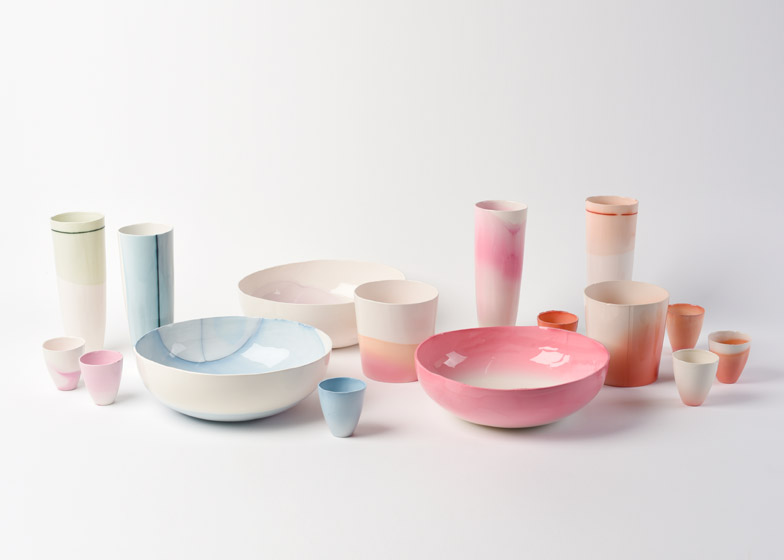Graduate shows 2015: Bath School of Art and Design graduate Emma Buckley has coloured a range of decorative ceramic tableware by letting dye seep up through gaps in the glazing (+ slideshow).
Instead of using a coloured glaze to determine the hue of the vessels, Buckley's technique allows the clay pieces to absorb dye after they have been fired and glazed.
They are hand-thrown, fired and finished with transparent glaze before a small gap is sandblasted into the base. When immersed in fabric dye, the porous clay gradually absorbs the colouring to create an intensity of hue unobtainable with traditional methods.
The designer developed the colouring method during her degree in 3D design at Bath School of Art and Design, while searching for new applications for the bright colours used in fabric production.
"There is a vast palette of really great colours you can achieve using dye, which seemed to be unique to the textile industry," she told Dezeen.
"I wanted to find a way to apply these colours to something other than textiles, so I started dyeing lots of other materials to see if there was anything that would take to the dye as well, and I came across ceramics."
The vessels are made of earthenware clay, as the material can be set in the kiln at a lower temperature and therefore stays porous enough to absorb the dye. They are fired at 900 degrees celsius, turning the clay into bisque, then covered in the clear, colourless glaze.
The undersides of pots are usually left unglazed, but as the dye seeps out as easily as it is absorbed, the Dye Lines collection needs to be glazed all over. They are then fired a second time at between 1,100 and 1,200 degrees celsius.
The pores shrink at this stage, meaning that the Procion MX dye used by Buckley is the only type that is soluble enough to be absorbed.
When the sandblasted vessel is placed in the dye, the porous section of exposed ceramic absorbs the dye using capillary action. Alternating dye with bleach creates ombre-style stripes in the piece.
The pattern changes over time; the saturated colour becomes muted as the water carrying particles of dye slowly evaporates through the point from which it entered, leaving the residue of dye behind. The colour is only fixed once this process is complete.
"I hope this project encourages people to become more interested in how things are made," said Buckley. "For me, the making process is often the most intriguing part and can sometimes be as beautiful as the final outcome."
Similarly, Spanish designer Oscar Diaz made a calendar that uses the capillary action of ink spreading across paper to display the date, and more recently Designers Not Tom created an installation in which coloured dye rose out of paint tins and along tree branches wrapped in wool.






